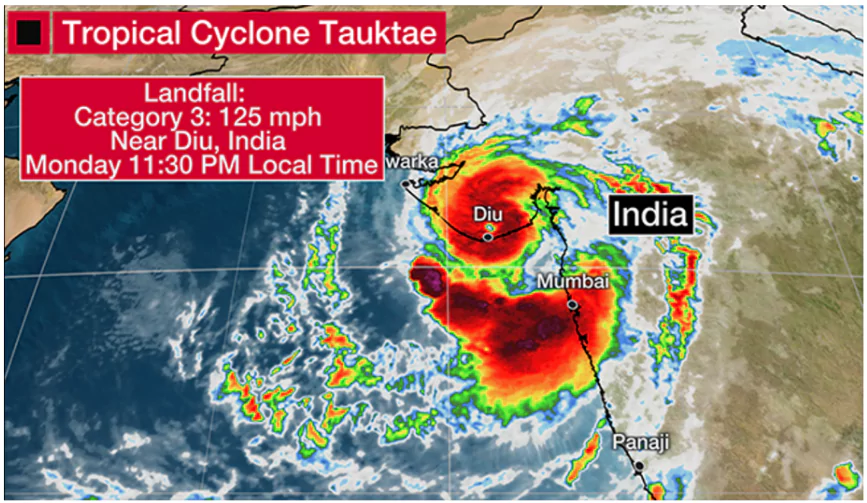Scientists from the Indian National Centre for Ocean Information Services (INCOIS), Hyderabad, have studied the causes behind the rapid intensification and formation of Cyclone Tauktae in 2021.
Overview of Cyclone Tauktae
- Cyclone Tauktae is a tropical cyclone named Myanmar.
- The word “Tauktae” means ‘gecko,’ a vocal lizard, in the Burmese language.
 Occurrence Period:
Occurrence Period:-
- Tropical cyclones in the North Indian Ocean region (Bay of Bengal and Arabian Sea) usually form during:
- Pre-monsoon period: April to June.
- Post-monsoon period: October to December.
- Cyclone Tauktae occurred in the Arabian Sea from May, 2021.
- It was categorized as an “extremely severe cyclonic storm.”
- Main Causes of Rapid Intensification of Cyclone Tauktae
- Atmospheric and Land Heating:
- Increased heating in the atmosphere and land played a significant role, slightly more than the ocean.
- Researchers found that both the atmosphere and ocean contributed to the intensification of Tauktae, with the atmosphere playing a slightly larger role (54%).
- High humidity levels, sea surface temperatures, and ocean heat potential contributed to the cyclone’s intensification.
- Role of Soil and Land:
- Near the west coast, moist soil with temperatures above 25°C released latent heat into the atmosphere, strengthening the storm.
- Other Contributing Factors
- La Niña: Cooling of the Pacific Ocean, which impacts the Indian Ocean and monsoon.
- Negative Indian Ocean Dipole (IOD): Another climatic factor that affects monsoon patterns.
- Atmospheric Oscillations: Helped increase relative humidity, leading to cyclone intensification.
Tropical Cyclones
- A tropical cyclone is an intense, circular storm originating over warm tropical oceans. It is marked by low atmospheric pressure, strong winds, and heavy rainfall.
- Key Features:
- The central part of the cyclone, known as the eye, is characterized by clear skies, warm temperatures, and low pressure.
- Rotation:
- In the Northern Hemisphere, cyclones rotate counterclockwise.
- In the Southern Hemisphere, they rotate clockwise.
Conditions Favoring Cyclone Formation
For a tropical cyclone to form and intensify, the following conditions are essential:
- Warm sea surface temperatures (above 27°C).
- Coriolis Force (which influences cyclone rotation).
- Minimal variation in vertical wind speed.
- Pre-existing low-pressure area.
- Upper-level divergence (spreading of air at high altitudes).
Classification of Cyclones
- Cyclone Tauktae weakened from an “Extremely Severe Cyclonic Storm” to a “Very Severe Cyclonic Storm.”
- India Meteorological Department (IMD) classifies cyclones based on the Maximum Sustained Surface Wind Speed (MSW):
-
- Severe Cyclone: MSW of 48-63 knots.
- Very Severe Cyclone: MSW of 64-89 knots.
- Extremely Severe Cyclone: MSW of 90-119 knots.
- Super Cyclonic Storm: MSW of 120 knots or more.
(Note: One knot equals 1.8 kilometers per hour).
|
![]() 21 Mar 2025
21 Mar 2025

 Occurrence Period:
Occurrence Period: